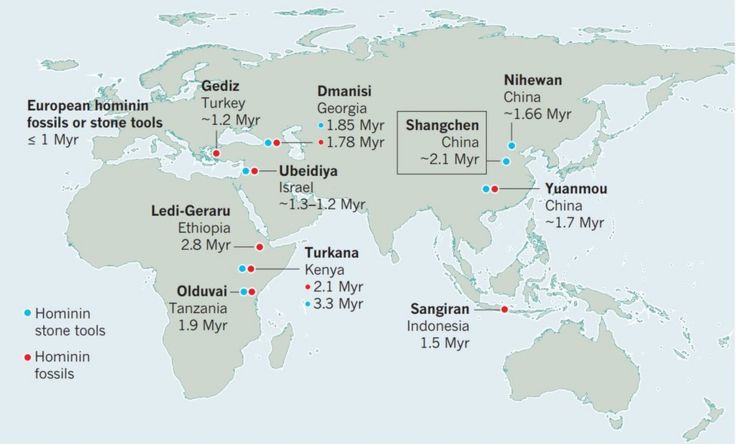-
11 July 2018
В Китае обнаружены древнейшие за пределами Африки останки первобытных людей
Июль 2018
Опубликовано 2018-07-12 16:00
Опубликовано 2018-07-12 16:00
Earliest evidence of humans outside Africa
 Image copyrightPROF ZHAOYU ZHU
Image copyrightPROF ZHAOYU ZHUScientists say they've found the earliest known evidence of a human presence outside Africa.
Stone tools discovered in China suggest primitive humans - or a close relative - were in the region as early as 2.12 million years ago.
They are about 270,000 years older than the previous earliest evidence, which consists of bones and tools from Dmanisi in Georgia.
The research, by a Chinese-British team, appears in the journal Nature.
The stone artefacts were discovered at Shangchen on a plateau in northern China.
They comprise different types of stone tools constructed for a variety of purposes. All show signs of having been used.
Most were made of quartzite and quartz rock that probably came from the foothills of the Qinling Mountains, five to 10 km to the south of the dig site.
But we don't know for sure which species of human relative made them.
 Image copyrightNATURE
Image copyrightNATURE
Why does it matter?
Humans left Africa at many times during their history. Living people outside Africa, for example, trace their origins to an exodus that occurred 60,000 years ago.
But there had been no evidence of occupation by human relatives in Eurasia until the Dmanisi evidence at 1.8 million years ago.
Writing in Nature, palaeoanthropologist John Kappelman, who was not involved with the new study, commented: "The roughly 14,000-kilometre trek from eastern Africa to eastern Asia represents a range expansion of dramatic proportions."
Africa has traditionally been seen as the engine of human evolution - where key species arose before spreading out through the rest of the world.
However, some scientists have proposed a more important role in this story for Asia. With these new finds, some researchers will wonder how much further back the human story goes in Asia.
What prompted humans to leave Africa?
Co-author Prof Robin Dennell, from the University of Exeter, UK, said he believes evidence from Ethiopia offers some clues. Early human relatives (hominins) learnt how to produce sharp stone "flakes" around 2.6 million years ago.
"That way they acquired a simple but effective tool kit that could strip meat off a carcass before they were chased off by bigger and stronger predators (e.g. lions, hyaena). This opened up a new world for them," Prof Dennell told BBC News.
He added: "With those new skills, they were able to expand out of Africa into the grasslands and open woodlands of Asia, in much the same type of environment as in East Africa. The Asian fauna at that point had never encountered a bipedal, tool-using, carnivorous ape before, and I suspect hominins found it easy to acquire meat."
 Image copyrightZHAOYU ZHU
Image copyrightZHAOYU ZHU
Could we find even earlier evidence outside Africa?
If our ancient relatives were in China by two million years ago, there must be earlier evidence in more westerly parts of Asia, closer to the exit point from Africa.
Robin Dennell explained: "I think the hominin record in Asia could go back to 2.5 - 2.6 Ma (million years) - around the time that hominins opened up a new niche by flaking stone."
He said the discovery showed Asia was "absolutely fundamental" in human evolution.
"We are now moving beyond a Eurocentric view of human evolution in Eurasia: the Asian record for human evolution is proving to be as complex and fascinating as in Europe and Africa," said Prof Dennell.
Did climate change have a role in this?
Some 80 artefacts were found in fossil soil that developed in a warm and wet climate. A further 16 tools were found in fossil soil that came from times when it was colder and drier.
All in all, the scientists believe humans lived on the Loess Plateau in China for a significant amount of time - from 1.3 to 2.1 million years ago. It's likely they also survived there under a variety of climatic conditions.
Dr Kappelman, from the University of Texas, Austin, wrote: "The hominin dispersal probably occurred under the variable climates of the Pleistocene ice age. Does a migration to higher latitudes suggest the evolution of behavioural adaptations to colder climates? Perhaps.
"Rather than maintaining a continuous occupation of the Loess Plateau, the hominin population might have increased or dwindled, depending on the climate."
Does this have anything to do with the Indonesian "Hobbit"?
Homo floresiensis, dubbed the "Hobbit", is a tiny, extinct species of human that lived until about 12,000 years ago on the Indonesian island of Flores. One of the adults measured just 1.1m (3.7ft) tall.
Many scientists think the Hobbit is a diminutive form of Homo erectus - long thought to be the first human species to leave Africa. Under this scenario, H. erectus arrived on Flores hundreds of thousands of years ago and shrank in size after becoming isolated there.
Others point out that aspects of the Hobbit's anatomy look too primitive for H. erectusto be the ancestor. They wonder whether the Hobbit's progenitor was an australopithecine - an earlier and more ape-like relative that roamed Africa, but has never been found outside the continent.
Robin Dennell said: "My preference is that the makers of the 2.1 Ma (million-year-old) artefacts at Shangchen were a primitive form of Homo (human) - which is not very unlike an australopithecine at that point in time.
"This discovery does lend some support to the possibility that H. floresiensis has a primitive australopithecine-type ancestor. Obviously, we need the skeletal evidence, as well as an open mind - there is so much that we don't know, and the Shangchen evidence is just another piece in a very complex jigsaw."
|
Оставлять комментарии могут только зарегистрированные пользователи. Войдите в систему используя свою учетную запись на сайте: |
||